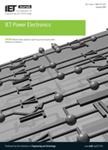版权所有:内蒙古大学图书馆 技术提供:维普资讯• 智图
内蒙古自治区呼和浩特市赛罕区大学西街235号 邮编: 010021

作者机构:Nanyang Technol Univ Sch Elect & Elect Engn Singapore Singapore Southwest Jiaotong Univ Sch Elect Engn Chengdu Peoples R China
出 版 物:《IET POWER ELECTRONICS》 (IET Power Electron.)
年 卷 期:2020年第13卷第18期
页 面:4150-4157页
核心收录:
基 金:Nanyang Assistant Professorship from Nanyang Technological University Singapore
主 题:autoregressive processes learning (artificial intelligence) electric sensing devices PWM rectifiers fault diagnosis fault tolerant control data handling feedforward neural nets control engineering computing current sensor fault diagnosis fault-tolerant control single-phase PWM rectifier data-driven method single-phase pulse width modulation rectifier model-based methods diagnostic method mathematical model signal prediction model nonlinear autoregressive exogenous learning model data-driven prediction model sensor signal prediction hybrid model-based method residual generation randomised learning extreme learning machine hardware-in-the-loop tests real-time application
摘 要:In this study, a hybrid model-based and data-driven method is proposed for the current sensor fault diagnosis used in single-phase pulse width modulation (PWM) rectifier. According to the principle of model-based methods, the proposed diagnostic method is based on signal prediction and residual generation. Differently, instead of a mathematical model, the signal prediction model is developed based on a data-driven method. Non-linear autoregressive exogenous learning model, randomised learning technique, and extreme learning machine are utilised to generate the data-driven prediction model. Once the fault is detected, fault-tolerant control is activated by substituting the predicted signal for the information of faulty sensors. The offline test shows that the proposed method is able to predict the sensor signal accurately with the root mean square error of 4.276 x 10(-5). In addition, hardware-in-the-loop tests are conducted to verify the feasibility and reliability of the proposed method in the real-time application.